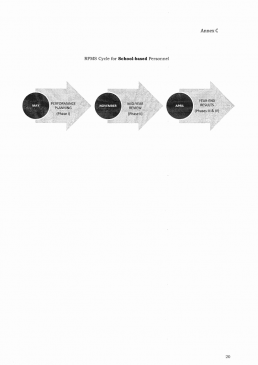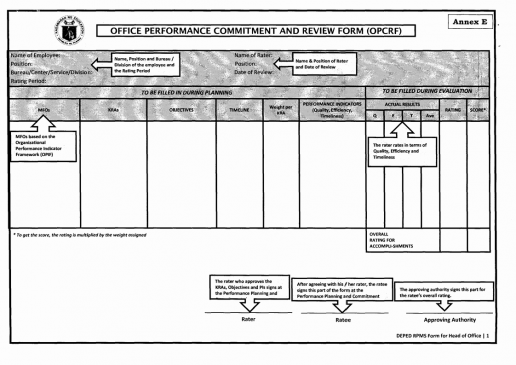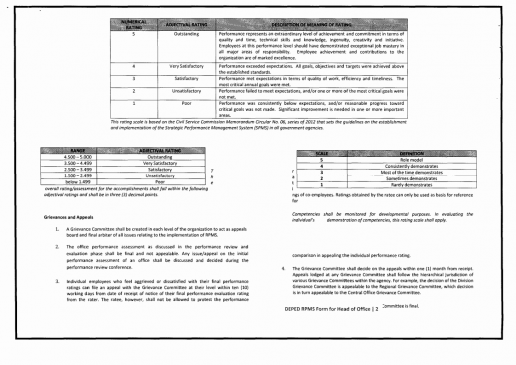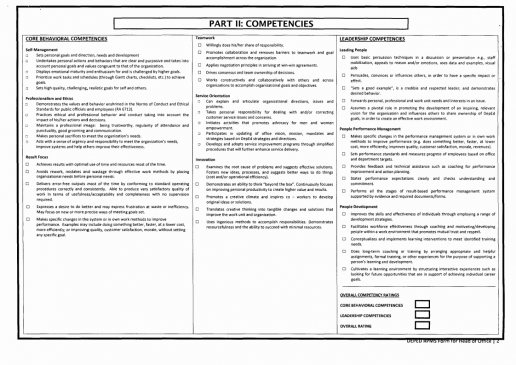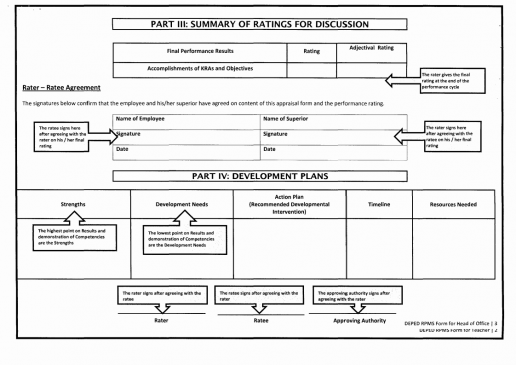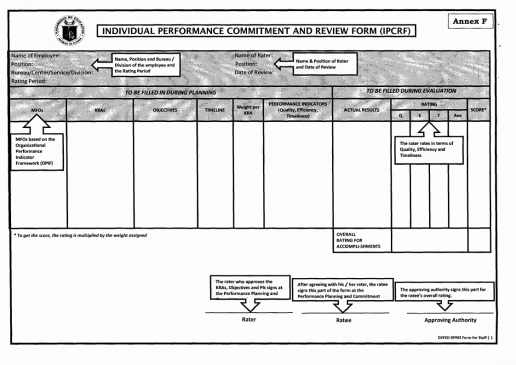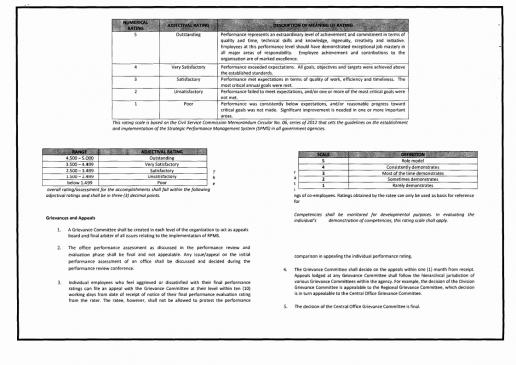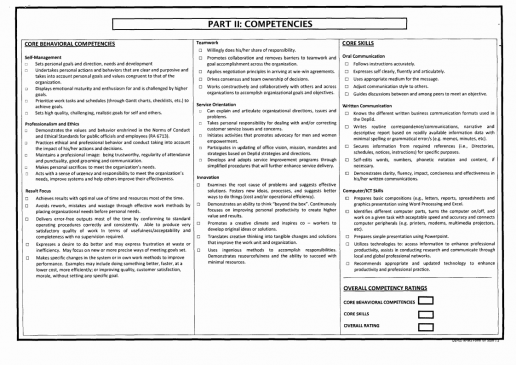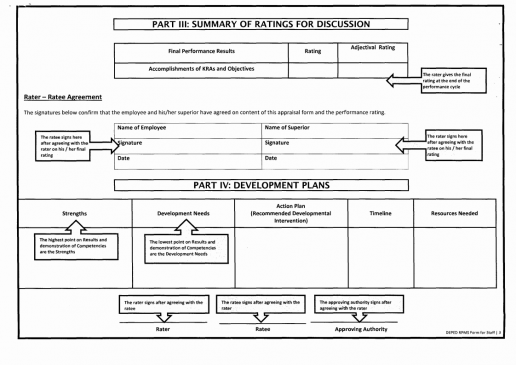DepEd Order 2, S. 2015
Guidelines on the Establishment and Implementation of RPMS in the Department of Education
February 6, 2015
DO 2, s. 2015
Guidelines on the Establishment and Implementation of the Results-Based Performance Management System (RPMS) in the Department of Education
To: Undersecretaries
Assistant Secretaries
Bureau Directors
Directors of Services, Centers and Heads of Units
Regional Directors
Schools Division Superintendents
Heads, Public Elementary and Secondary Schools
All Others Concerned
- This Department issues the enclosed Guidelines on the Establishment and Implementation of the Results-Based Performance Management System (RPMS) in the Department of Education (DepEd).
- It aims to provide comprehensive guidelines for the adoption of the Civil Service Commission’s (CSC) Strategic Performance Management System (SPMS) in DepEd.
- These guidelines stipulate the specific mechanisms, criteria and processes for the performance target setting, monitoring, evaluation and development planning for schools and offices, covering all officials and employees, school-based and non school-based, in the Department holding regular plantilla positions. Personnel under contracts of service/job order and LGU-funded employees shall likewise be covered, but for purposes of performance evaluation only.
- All provisions of DepEd rules, regulations, and issuances which are inconsistent with these guidelines are hereby repealed or modified accordingly.
- This Order shall take effect immediately upon its issuance.
- Immediate dissemination of and strict compliance with this Order is directed.
(Sgd.) BR. ARMIN A. LUISTRO FSC
Secretary
Encl.: As stated
Reference: None
To be indicated in the Perpetual Index under the following subjects:
EMPLOYEES
OFFICIALS
PERFORMANCE
POLICY DO_s2015_02
(Enclosure to DepEd Order No., 2, s. 2015)
GUIDELINES ON THE ESTABLISHMENT AND IMPLEMENTATION OF THE RESULTS-BASED PERFORMANCE MANAGEMENT SYSTEM IN THE DEPARTMENT OF EDUCATION
I. Rationale
- The Civil Service Commission (CSC), through the issuance of Memorandum Circular (MC) No. 06, series of 2012, sets the guidelines on the establishment and implementation of the Strategic Performance Management System (SPMS) in all government agencies. The SPMS gives emphasis to the strategic alignment of the agency’s thrusts with the day-to-day operation of the units and individual personnel within the organization. It focuses on measures of performance vis-a-vis the targeted milestones, and provides a credible and verifiable basis for assessing the organizational outcomes and the collective performance of the government employees.
- As a learner-centered institution, the Department of Education (DepEd) is committed to continuously improve itself to better serve the Filipino learners and the community. The adoption of the SPMS in DepEd strengthens the culture of performance and accountability in the agency, with the DepEd’s mandate, vision and mission at its core.
- There is a need to concretize the linkage between the organizational thrusts and the performance management system. It is important to ensure organizational effectiveness and track individual improvement and efficiency by cascading the institutional accountabilities to the various levels, units and individual personnel, as anchored on the establishment of a rational and factual basis for performance targets and measures. Finally, it is necessary to link the SPMS with other systems relating to human resources and to ensure adherence to the principle of performance-based tenure and incentives.
- In view of the above, this Order aims to adopt the SPMS as the Results-based Performance Management System (RPMS).
II. Scope of Policy
5. This DepEd Order provides for the establishment and implementation of the RPMS in all DepEd schools and offices, covering all officials and employees, school-based and non school-based, in the Department holding regular plantilla positions. It stipulates the specific mechanisms, criteria and processes for the performance target setting, monitoring, evaluation and development planning.
6.The following personnel shall likewise be covered by these guidelines but for purposes of performance evaluation only:
i. Personnel under contracts of service/job pursuant to CSC MC No. 17, s. 2002 entitled “Policy Guidelines for Contract of Services”; and
ii. LGU-funded employees.
III. Definition of Terms and Acronyms
- For purposes of this Order, the following terms shall be defined and understood as:
i. Head of Office refers to the approving authority enumerated in Annex A who determines the final performance rating of individual employees based on proof of performance.
ii. Individual Performance Commitment and Review Form (IPCRF) is the form that shall reflect the individual commitments and performance, which shall be accomplished by individual employees.
iii. Key Result Area (KRA) is a broad category of general outputs or outcomes. It is the mandate or function of the office and/or individual employee. The KRA is the reason why an office and/or job exist. It is an area where the office and/or individual employee are expected to focus on.
iv. Major Final Output (MFO) is a good or service that an organization, unit and/or individual personnel is mandated to deliver to internal and external clients through the achievement of specific objectives under the key result areas.
v. Non School-based Personnel include all regular/permanent, LGU-funded and contract of service/job detailed in rder personnel assigned and/or DepEd offices, from the central office to the schools division offices.
vi. Objective is a specific task that an office and/or individual employee needs to do to achieve the major final outputs under the key result areas.
vii. Office Performance Commitment and Review Form (OPCRF) is the form that shall reflect the office commitments and performance, which shall be accomplished by the head of office.
viii. Organizational Performance Indicator Framework (OPIF) is a results-based management approach being mainstreamed by the Government of the Philippines (GOP) as one of the pillars of its public expenditure management (PEM) reforms. Through OPIF and other reforms, the PEM seeks to change the orientation of expenditure management from focusing on rules and processes to focusing on three key objectives or outcomes: fiscal discipline, allocative efficiency and operational efficiency.
ix. Performance-Based Bonus (PBB) is a top-up bonus given to government personnel in accordance to their contributions to the accomplishment of the organization’s overall targets and commitments.
x. Performance Indicator (PI) is an exact quantification of objectives, which shall serve as an assessment tool that gauges whether a performance is positive or negative.
xi. Performance Management System (PMS) is a mechanism to manage, monitor and measure performance.
xii. Performance Monitoring and Coaching Form (PMCF) is the form intended for capturing the significant incidents.
xiii. Planning Office. The following are the designated Planning Offices at each level:
a. Central Office – Planning and Programming Division – Office of the Planning Service
b. Regional Office – Regional Planning Uni
c. Schools Division Office – Division Planning Unit
d. School – School Planning Team
xiv. Qualification Standards (QS) are the minimum and basic requirements for positions in the government. These shall serve as the basic guide in the selection of personnel and in the evaluation of appointments to all positions in the government.
xv. Ratee refers to the individual employee concerned. The rater-ratee relationship is enumerated in Annex A.
xvi. Rater refers to the immediate superior who directly supervises the performance of the individual employee and gives the preliminary rating for approval of the head of office at the end of the rating period based on the performance measures.
xvii. Results-based Performance Management System (RPMS) refers to the DepEd-contextualized SPMS. It is an organization-wide process of ensuring that employees focus work efforts towards achieving DepEd vision, mission, values, and strategic priorities. It is also a mechanism to manage, monitor and measure performance, and identify human resource and organizational development needs.
xviii. School-based Personnel include all regular/permanent, LGU-funded and contract of service/job order teaching, teaching-related and non-teaching personnel assigned and/or detailed in the schools including mobile teachers.
xix. Significant incidents are actual events and behaviors in which positive and negative performances are observed and documented.
xx. SMART Criteria refers to the criteria by which the objectives are identified. The SMART stands for Specific, Measurable, Attainable, Relevant, Time Bound.
xxi. Strategic Performance Management System (SPMS) refers to the CSC PMS that gives emphasis to the strategic alignment of the organizational goals with the day-to-day operation of units and individual personnel.
- The following acronyms shall be used throughout this Order to mean:
i. BHROD – Bureau of Human Resource and Organizational Development.
ii. CO – Central Office
iii.CSC – Civil Service Commission
iv. EO – Executive order
v. HR – Human Resource
vi. HRD – Human Resource Division
vii. HRMO – Human Resource Management Office
viii. HROD- Human Resource and Organizational Development
ix. M&E – Monitoring and Evaluation
x. MC – Memorandum Circular
xi. PERC – Performance Evaluation Review Committee
xii. PRAISE – Program on Awards and incentive for Service Excellence
xiii. RO – Regional Office
xiv. SDO – School Division Office
xv. VMV – Vision, Mision, Values
IV. Policy Statement
- The DepEd hereby sets the guidelines on the establishment and implementation of the Results-based Performance Management System. (RPMS) in the Department, stipulating the strategies, methods, tools and rewards for assessing the accomplishments vis-a-vis the commitments. This will be used for measuring and rewarding higher levels of performance of the various units and development planning of all personnel in all levels.
- For non school-based personnel, the RPMS shall provide for an objective and verifiable basis for rating and ranking the performance of units and individual personnel in view of the granting of the Performance-Based Bonus (PBB) starting 2015.
- For school-based personnel, the RPMS shall be used only as an appraisal tool, which shall be the basis for training and development. The granting of PBB shall be governed by the existing PBB guidelines.
- The Department shall adopt the RPMS framework shown in Annex B.
- The DepEd RPMS shall follow the four-stage performance management system cycle as prescribed by the CSC:
i. Performance planning and commitment (Phase I);
ii. Performance monitoring and coaching (Phase II);
iii. Performance review and evaluation (Phase III); and
iv. Performance rewarding and development planning (Phase IV).
V. Performance Cycle/Process
- The RPMS shall align the performance targets and accomplishments with the Department’s mandate, vision, mission and strategic goals. It shall ensure 100% results orientation vis-a-vis the planned targets. On the other hand, the ratee’s demonstration of the required competencies shall be monitored for developmental purposes only.
- The RPMS cycle shall cover performance for one whole year. All school-based personnel shall follow a performance cycle starting in April of the current year and ending in March of the following year; while non school-based personnel shall follow a performance cycle starting in January and ending in December. Annexes C and D illustrate the performance cycles which shall apply to school-based and non school- based personnel, respectively.
- The performance planning and commitment shall be done prior to the beginning of the performance cycle; while the performance monitoring and coaching shall take place immediately after Phase I, and continue throughout the performance cycle. The performance review and evaluation, as well as the performance rewarding and development planning shall be done at the end of the performance cycle.
A. Phase I: Performance Planning and Commitment
- The performance planning and commitment shall be done prior to the start of the performance cycle where the rater meets with the ratee to discuss and agree on the following:
i. Office KRAs, Objectives and Performance Indicators as anchored to the overall organizational outcomes; and
ii. Individual KRAs, Objectives and Performance Indicators as anchored to the Office KRAs and Objectives.
- The Office Performance Commitment and Review Form (OPCRF) shall be accomplished by the head of office to reflect the Office KRAs, Objectives and Performance Indicators. The head of office, in coordination with the Planning Office, shall ensure alignment of the office plans and commitments to the overall organizational outcomes. The OPCRF shall be equivalent to the IPCRF of the head of office. A sample of the filled out OPCRF, including the instructions for accomplishing the form, is shown in Annex E.
- The Individual Performance Commitment and Review Form (IPCRF) shall be accomplished by the individual personnel to reflect the agreed Individual KRAs, Objectives and Performance Indicators. A sample of the filled out IPCRF, including the instructions for accomplishing the form, is shown in Annex F.
- Defining the Key Result Areas. The head of office, in coordination with the Planning Office, shall define the office KRAs as anchored on the overall organizational outcomes. The rater and the ratee shall discuss and agree on the break down of the office KRAs into individual KRAs. Three (3) to five (5) KRAs shall be defined for each office and individual employee.
KRAs are broad categories of general outputs or outcomes. It is the mandate or individual employee. The KRA is the reason why an function of the office and/or office and/or job exist. It is an area where the office and/or individual employee are expected to focus on.
- Setting the Objectives. The head of office shall set three (3) objectives per office KRA. The rater and the ratee shall discuss and agree on three (3) objectives per individual KRA.
Objectives are specific tasks, which an office and/or employee need to do to achieve their specific KRAs. In objective setting, the SMART criteria, which stands for Specific, Measurable, Attainable, Relevant, Time Bound, shall be applied. The SMART criteria are illustrated in Annex G.
- Setting the Timeline. The timeline shall define the target date for accomplishing each of the Objectives. The timeline for the office Objectives shall be set by the head of office in coordination with the Planning Office and School Planning Team; while the timeline for the individual Objectives shall be discussed and agreed by the rater and the ratee.
- Assigning the Weight. Assigning of weights shall be done per KRA. Weights for each office KRA shall be assigned by the head of office in coordination with the Planning Office; while the weights for each of the individual KRAs shall be discussed and agreed upon by the rater and the ratee.
- Identifying the Performance Indicators. Using a five (5)-point rating scale, the head of office shall identify a performance indicator for each of the office objectives, while the rater and the ratee shall identify and agree on the performance indicator for each of the individual objectives.
Performance indicators are exact quantification of objectives expressed through rubrics. They are assessment tools, which gauge whether a performance is positive or negative.
In identifying the performance indicator, the operational definition or meaning of each numerical rating shall be indicated under each relevant dimension (i.e., quality, efficiency, or timeliness) per performance target or success indicator. This shall ensure that the rating is objective, impartial and verifiable. Table 1 below discusses the performance measures by which the indicator must satisfy.
Table 1. Performance Measures
Some Performances are only rated on quality and efficiency, some on quality and timeliness, and others on efficiency only. You need not use all three (3) categories.
- Demonstration of Competencies. During Phase I, the rater shall discuss with the ratee the competencies required of the individual personnel.
Competencies are defined as the knowledge, skills and behavior that individuals demonstrate in achieving one’s results. Competencies shall uphold the DepEd’s core values. They represent the way individuals define and live the values.
- DepEd shall adopt four classes of competencies as follows:
i. Core behavioral competencies are competencies, which cut across the organization;
ii. Leadership competencies are competencies intended for managerial positions;
a. Third level officials
b. Chiefs and Assistant Chiefs
c. School Heads and Department Heads
iii. Staff Core Skills are competencies intended for staff and teaching-related personnel; and
iv. Teaching competencies are competencies intended for teachers.
The DepEd-required competencies are illustrated in Annex I.
- The ratee’s demonstration of the required competencies shall be monitored to effectively plan the interventions needed for behavioral and professional development. The assessment in the demonstration of competencies shall not be reflected in the final rating.
- Reaching Agreement. Once the office and individual KRAs, Objectives and Performance Indicators are clearly defined, the rater and the ratee shall commit and reach an agreement by signing the OPCRF and IPCRF. The signed/approved OPCRF and IPCRF shall be the basis for monitoring and assessment, which shall take place in Phases II and III, respectively.
B. Phase II: Performance Monitoring and Coaching
29. The performance monitoring and coaching shall commence after the rater and the ratee commit on the KRAs, Objectives and Performance Indicators, and sign the OPCRF and IPCRF. This shall be done throughout the year.
30. The two (2) main components of Phase II are the following:
i. Performance monitoring; and
ii. Coaching and feedback.
31. Performance monitoring shall provide key inputs and objective basis for rating. It facilitate feedback and provide evidence of performance.
Performance monitoring shall be the responsibility of both the rater and the ratee who agree to track and record significant incidents through the use of the Performance Monitoring and Coaching Form (PMCF) shown in Annex J. Significant incidents are actual events and behaviors in which both positive and negative performances are observed and documented.
32. Coaching and feedback shall be a continuous process. Coaching and feedback shall be provided by the rater and/or shall be sought by the ratee to improve work performance and behavior.
The rater, as the coach or mentor of the ratee, playing a critical role in the performance monitoring and coaching, shall provide an enabling environment and intervention to improve the office performance and to manage and develop individual potentials.
33. The PMCF shall capture the significant incidents. It shall provide a record of demonstrated behaviors, competencies and performance, and shall be an effective substitute in the absence of quantifiable data. The rater and the ratee shall sign each significant incident recorded in the PMCF to ensure that agreement has been reached.
C. Phase III: Performance Review and Evaluation
34. The performance review and evaluation shall be done at the end of the performance cycle to assess the office and individual employee’s performance level based on the commitments and measures as contained in the signed OPCRF and IPCRF
35. A mid-year review is prescribed to determine the progress in achieving the Objectives. In exceptional cases, and only if the situation warrants, a one-time recalibration of office and individual Objectives shall be allowed during the mid-year review.
Exceptional cases shall include instances when high level decisions are taken into effect such as changes in strategic directions, and circumstances beyond the control of the ratee such as natural and/or man-made calamities, including typhoon, earthquake and other fortuitous events.
During the mid-year review, the rater shall inform in writing the ratee of the status of performance, in case of an Unsatisfactory or Poor performance. Coaching, feedback and appropriate interventions shall be provided where necessary.
36. The RPMS shall put premium on KRAs towards the realization of organizational vision, mission, strategic priorities and the OPIF logframe. Hence, rating for planned and/or intervening tasks shall always be supported by reports, documents or any output as proofs of actual performance. In the absence of said bases or proofs, a particular task shall not be rated and shall be disregarded.
37. Office and Individual Performance Assessment. The head of office, in coordination with the Planning Office, shall assess the performance of the office vis- -vis the committed targets at the beginning of the performance cycle. The rater and the ratee shall discuss and agree on the individual assessment based on the actual accomplishments of each of the KRAs and Objectives. The final rating shall be based solely on the accomplishment of the specific objectives as measured by the Performance Indicators. The OPCRF and IPCRF shall be accomplished and completed by the rater and the ratee to:
i. Reflect actual accomplishments and results;
ii. Rate each of the objectives;
iii. Compute for the score per objective;
iv. Determine the overall rating for accomplishments;
v. Reach an agreement; and
vi. Assess the competencies.
- Initial self-rating shall be encouraged prior to the rater-ratee discussion.
- Third Level Officials, as heads of offices, shall accomplish the OPCRF for submission to the Planning Office. The individual assessment of Third Level Officials shall be contained in the CESPES Forms for submission to the Career Executive Service Board (CESB). The BHROD and Personnel Division shall be furnished a copy of both forms.
- Actual Results. The rater and the ratee shall discuss and agree on the actual accomplishments and results based on the performance commitments and measures made at the beginning of the rating period. They shall evaluate each objective whether it has been achieved or not. The significant incidents as reflected in the PMCF shall be considered for the actual results.
- Rating the Objectives. Based on the actual accomplishments and results, each of the Objectives shall be rated using the rating scale specified below:
Table 2. The RPMS Rating Scale
The final assessment shall correspond to the adjectival description of Outstanding, Very Satisfactory, Satisfactory, Unsatisfactory or Poor.
The range of adjectival rating is as per attached in Forms A, B, and C.
- Process for Computing the Score per KRA.
i. The rater and ratee shall ensure that each KRA has been assigned weight according to priority.
ii. As an option, the rater and ratee may assign weights to objectives which shall be equal to the total weight assigned to a particular KRA.
KRA 1 – Weight assigned is 40%
Objective 1 is 20%
Objective 2 is 10%
Objective 3 is 10%
iii. The score per KRA shall be computed using the following formula:
Rating per KRA = Weight x Rating
Total/Final Rating = KRAI + KRA2 + KRA3 + KRA 4 (Plus Factor)
Sample Computation:
- Plus Factor. The plus factor shall be considered as another KRA. These are value adding accomplishments, which are not covered within the regular duties and responsibilities. The weight on the plus factor shall not exceed the weight of the highest mandated KRA.
For teachers, the plus factor shall be limited to work/activities, which contribute to the teaching-learning process.
- Determining the Overall Rating for Accomplishments. The overall rating/assessment for the accomplishments shall fall within the following adjectival ratings and shall be in three (3) decimal points:
Table 3. Adjectival Ratings
- Reaching Agreement. Upon determining the overall rating for the actual accomplishments and results, the rater and the ratee shall reach an agreement by signing the OPCRF and IPCRF
The average rating of individual staff members should not go higher than the collective performance assessment of the office.
- Assessing the Competencies. The rater shall discuss with the ratee the set of competencies observed during the performance cycle. The competencies shall not bereflected in the final rating. Competencies shall be monitored for developmental purposes. In evaluating the individual’s demonstration of competencies, the rating scale in Table 4 shall apply:
Table 4. The DepEd Competencies Scale
Phase IV: Performance Rewarding and Development Planning
47. The results of the performance review and evaluation shall be used in performance rewarding and development planning. This phase shall be done after Phase III.
- The rater shall discuss and provide qualitative comments, observations and recommendations in the individual employee’s performance commitment, competency assessment and significant incidents which shall be used for training and professional development. These can be written under the strengths and development needs column of the Part IV-Development Plans of the IPCRF
- The rater and the ratee shall identify and discuss the individual’s strengths and needs, and reflect them in the Part IV-Development Plans of the IPCRF. The competencies which the ratee demonstrated consistently and the areas, where the ratee meet or exceed expectations shall be referred to as the ratee’s strengths. The competencies, which the ratee rarely demonstrates and the areas where the ratee has room for improvement and has not met the expectations, shall be identified as the ratee’s development needs.
PART IV: DEVELOPMENT PLANS
- For purposes of promotion and step increment, one (1) RPMS performance cycle shall be equivalent to two semestral rating periods.
- Employee development is a continuous learning process that enables the ratee to achieve his/her personal objectives within the context of the organizational goals. Employee development shall be a shared responsibility of the rater and the ratee, BHROD and the Organization. The summary of Development Plans Form shall be the basis for development planning.
- The following steps shall be applied in development planning:
i. Identify the development needs;
ii. Set goals for meeting the development needs;
iii. Prepare action plans for meeting the development needs such as list of learning activities, resources and support, measures of success, among other needs;
iv. Implement action plans; and
v. Evaluate.
53. The rater, ratee and BHROD shall ensure that the action plans and interventions for employee development are appropriate for the development needs and learning styles of the ratee. Below are sample activities of development action plans:
i. Self-managed learning;
ii. Benchmarking;
iii. Assignment to Task Forces/Committees/Special Projects;
iv. Job Enrichments/Redesign
v. Functional cross-posting;
vi. Regional cross-posting;
vii. Seminar/Workshops
viii. Formal Education/Classes
ix. Developmental/Lateral Career Moves; and
x. Coaching/ Counseling.
VI. Uses of Performance Ratings
- The results of the performance evaluation/assessment shall serve as inputs to the following:
i. Rater in identifying and providing the kinds of interventions needed, based on the development needs identified;
ii. BHROD or NEAP in consolidating and coordinating developmental interventions which shall form part of the HR Plan and shall be the basis for rewards and incentives;
iii. PMT in identifying potential PRAISE Awards nominees for various awards categories such as Lingkod Bayan Award and Metrobank Outstanding Teachers; and
iv. PRAISE Committee in determining top performers of the agency who qualify for awards and incentives.
- The PMT at each level shall validate the Outstanding Performance Ratings and shall recommend employees for performance-based rewards. Grants of performance-based incentives shall be based on the final ratings of employees as approved by the head of office. For Central Office, final decision shall be with the Executive Committee (ExeCom). Performance ratings shall be used as basis for promotion, training and scholarship grants and other personnel actions.
Employees with Outstanding and Very Satisfactory Performance Ratings shall be considered for the above-mentioned personnel actions and other related matters.
Employees and officials who obtained an Unsatisfactory or Poor Rating for one (1) rating period shall be provided with appropriate developmental intervention by the head of office and supervisor, in coordination with the BHROD/Personnel Division, to address competency-related performance gaps.
- Officials and employees who shall be on official travel, approved leave of absence, training or scholarship programs and who have already met the required minimum rating period of 90 days shall submit the performance commitment and rating report before they leave the office.
For purposes of performance-based benefits, employees who are on official travel, scholarship or training within a rating period shall use their performance commitment and ratings obtained in the immediately preceding rating period.
- Employees who are on detail to another office shall be rated in their present or actual office, copy furnished their mother office. The ratings of those who were detailed or seconded to another office during the rating period shall be consolidated in the office, either the mother (plantilla) office or present office, where the employees have spent majority of their time during the rating period.
Personnel on detail should submit a copy of their performance appraisal/rating from the office where they are on detail to DepEd.
VII. Monitoring and Evaluation
A. Submission of Accomplished Forms
- Each level shall undertake progress tracking to ensure continous submission and compliance with this Order. The following details shall be followed:
At the end of the performance cycle, file copy of accomplished and duly signed RPMS forms (OPCRF and IPCRF) shall be submitted by all offices to the Personnel Division at each level, which shall be attached to the individual personnel’s 201 file.
Likewise, an analysis report and file copies of accomplished and duly signed RPMS forms shall be submitted as follows:
i. Analysis of all OPCRF of the DepEd offices shall be submitted to the Planning Office at each level. Analysis of the OPCRF for schools shall be submitted to the School Effectiveness Division (SED).
ii. Analysis of the IPCRF shall be submitted as follows:
Central Office: Human Resource Development Division (HRDD)
Regional Office: Regional HRDD
Division Office: Human Resource Development Section
Schools: Office of the School Head, copy furnished the SDOs
B. Composition and Responsibilities of the RPMS Key Players
59. The Secretary as the RPMS Champion with the Executive Committee shall:
i. be primarily responsible and accountable for the establishment and implementation of the RPMS;
ii. set agency performance goals/objectives and performance measures;
iii. determine agency target setting period;
iv. approve office performance commitment and rating; and
v. Assess performance of Offices.
- The Composition of the Performance Management Team (PMT), which shall be established at the central, region, schools division offices and schools is detailed on the Table below:
Table 5. Composition of Performance Management Team
The PMT shall have the following functions and responsibilities:
i. The Secretariat at each level sets consultation meeting of all Heads of Offices for the purpose of discussing the targets set in the office performance commitment and rating form;
ii. The Planning Office shall ensure that Office performance targets and measures, as well as the budget are aligned with those of the agency and that work distribution of Offices/Units is rationalized;
iii. PMT recommends approval of the office performance commitment and rating to the Head of Agency;
( Election of school representatives shall follow the clustering of schools per district. )
iv. BHROD/Personnel Division identifies potential top performers and provide inputs to the PRAISE Committee for grant of awards and incentives; and
v. PMT adopts its own internal rules, procedures and strategies in carrying out the above responsibilities including schedule of meetings and deliberations and delegation of authority to representatives in case of absence of its members.
- The Planning Office shall:
i. conduct an agency performance planning and review conference annually for the purpose of discussing the Office assessment for the preceding performance period and plans for the succeeding rating period with concerned Heads of Offices; (This shall include participation of the Financial Office as regards budget utilization.)
ii. monitor and evaluates the submission of OPCRF and schedule the review/ evaluation of Office Commitments by the PMT at each level before the start of a performance period;
iii. consolidate, review, validate and evaluate the initial performance assessment of the Heads of Offices based on reported Office accomplishments against the success indicators, and the allotted budget against the actual expenses; (The result of the assessment shall be the basis of PMT’s recommendation to the Head of Agency who shall determine the final Office rating.) and
iv. provide each Office with the final Office Assessment to serve as basis of offices in the assessment of individual staff members.
- The Human Resource Development Division shall:
i. monitor submission of IPCRF by heads of offices;
ii. review the Summary List of Individual Performance Rating to ensure that the average performance rating of employees is equivalent to or not higher than the Office Performance Rating as recommended by the PMT and approved by the Head of Agency;
iii. provide analytical data on retention, skill/competency gaps, and talent development plans that align with strategic plans; and
iv. coordinate development interventions that will form part of the HR Plan.
- The Head of Office, including designated officials in an Acting or Officer-In-Charge (OIC) capacity, shall:
i. assume primary responsibility for performance management in his/her Office;
ii. conduct strategic planning session with the supervisors and staff and agree on the outputs that should be accomplished based on the goals/objectives of the organization and submits the Office Performance Commitment and Review Form to the Planning Office;
iii. review and approve individual employee’s Performance Commitment and Review Form for submission to the HRM Office/Personnel Office before the start of the performance period;
iv. submit a quarterly accomplishment report to the Planning Office based on the PMS calendar;
v. initially assess the office’s performance Using the approved Office Performance Commitment and Review Form;
vi. determine final assessment of performance level of the individual employees in his/her office based on proof of performance;
vii. inform employees of the final rating and identified necessary interventions to employees based on the assessment of developmental need;
viii. recommend and discuss a development plan with the subordinates who obtain Unsatisfactory performance during the rating period not later than one month after the end of the said period and prepares written performance not earlier than the third notice/advice to subordinates that a succeeding Unsatisfactory performance shall warrant administrative action; and
ix. provide preliminary rating to subordinates showing Poor performance not earlier than the third month of the rating period. A development plan shall be discussed with the concerned subordinate and issue a written notice than failure to improve their performance shall warrant administrative action.
- The Section Chief/Unit Head or equivalent shall:
i. assume joint responsibility with the head of office in ensuring attainment of performance objectives and targets;
ii. rationalize distribution of targets/tasks
iii. monitor closely the status of the performance of their subordinates and provide support and assistance through the conduct of coaching for the and individual employee; attainment of targets set by the Division/Unit
iv. assess individual employees’ performance; and
v. recommend developmental intervention.
- The Individual Employees shall act as partners of management and their co-employees in meeting organizational performance goals.
VIII. Disqualification Criteria
- Unless justified and accepted by the PMT, non-submission of the OPCRF to the Planning Office and the IPCRF to the BHROD within the specified dates shall be ground for employee’s disqualification for performance-based personnel actions that require the rating for the given period such as promotion, training, scholarship grants, and PBB, if the failure of the submission of the said forms is due to the fault of the employee.
IX. Sanctions
67. Any violation of reasonable office rules and regulations and simple neglect of duty for the supervisors or employees responsible for the delay or non-submission of the OPCRF and IPCRF shall be dealt with administratively.
68. Failure on the part of the head of office to comply with the required notices to their subordinates for their unsatisfactory or poor performance during a rating period shall be a ground for an administrative offense for neglect of duty.
X. Grievance
69. A Grievance Committee shall be created in each level of the organization to act as appeals board on all issues relating to the implementation of RPMS. The composition of the Grievance Committee is detailed on Table 6 below.
Table 6. Composition of the Grievance Committee
XI. Appeals
70. The office performance assessment as discussed in the performance review and conference shall be final and not appealable. Any issue/appeal on the initial performance assessment of an Office shall be discussed and decided during the performance review conference.
71. Individual employees who feel aggrieved or dissatisfied with their final performance ratings can file an appeal with the PMT within ten (10) days from the date of receipt of notice of their final performance evaluation rating from the Head of Office. An office/unit or individual employee, however, shall not be allowed to protest the performance ratings of other office/unit or co-employees. Ratings obtained by other office/unit or employees can only be used as basis or reference for comparison in appealing one’s office or individual performance rating.
72. The PMT shall decide on the appeals within one month from receipt.
Appeals lodged at any PMT shall follow the hierarchical jurisdiction of various PMTs in an agency. For example, the decision of the Provincial PMT is appealable to the Regional PMT which decision is in turn appealable to the National/Central Office PMT.
The decision of the PMT in the central office or departments may be appealed to the head of office.
- Officials or employees who are separated from the service on the basis of Unsatisfactory or Poor performance rating can appeal their separation to the CSC or at its regional office within 15 days from receipt of the order or notice of separation.
XII. Funding Requirements
- Funds for training, and monitoring and evaluation related to RPMS including preparation of materials/forms shall be charged against the Human Resource Training and Development (HRTD) Funds.
(Elected representatives shall follow the clustering of schools.)
XIII. References
75.The government issuances related to the RPMS are the following:
i. Civil Service Administrative Order No. 25 s. 2011 created an inter-agency task force on the harmonization of national government performance monitoring, information, and reporting system. This inter-agency task force developed the Results-Based Performance Management System (RBPMS) that established a common set of performance scorecard and harmonized national government performance monitoring, information, and reporting systems;
ii. CSC Memorandum Circular No. 6, s. 2012 provided guidelines in the establishment and implementation of agency Strategic Performance Management System;
iii. Joint CSC-Department of the Budget and Management (DBM) Joint Circular No. 1, s. 2012 provided the rules and regulations on the grant of step increments due to meritorious performance and length of service; and
iv. Executive Order No. 80, s. 2012 directed the adoption of a performance-based incentive system for government employees.
XIV. Repealing Clause
- All issuances which are inconsistent with the RPMS guidelines are hereby rescinded or modified accordingly such as DepEd Order No. 27, s. 2002 (Implementation of the Revised Performance Appraisal System of the Department of Education).
XV. Effectivity
77. These guidelines shall take effect immediately upon issuance.
Signed:
RIZALINO D. RIVERA
Undersecretary, Regional Operations
Approved:
LYDIA ALBA CASTILLO
Director IV,CSC NCR
Guidelines on the Establishment and Implementation of RPMS
Annex D
Annex E
Part II : Competencies
Part III: Summary of Ratings for Discussion
Annex F: IPCRF Form
Part III: Summary of Ratings for Discussion





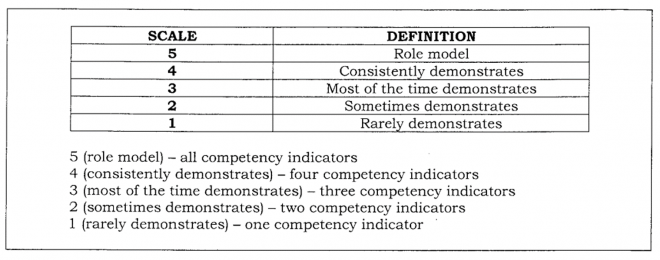


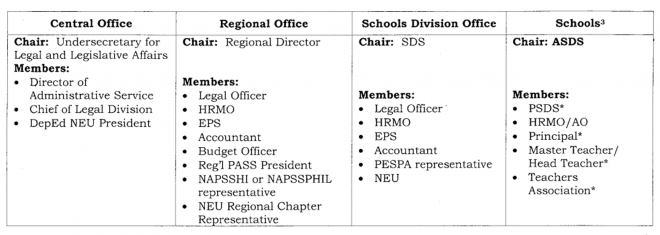
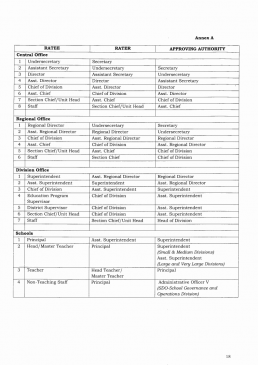 Annex B
Annex B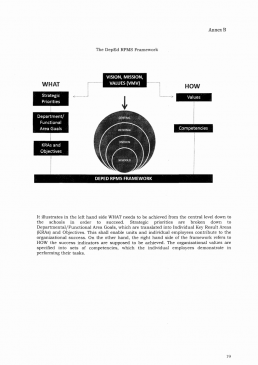 Annex C
Annex C